At a restaurant, you need to be reachable by your customers. Maybe they want to order pick-up. Maybe they want to make a reservation. Maybe they want to know your hours. Whatever they want, you must have a phone to talk with them.
How do you find the best VoIP phone for a restaurant environment?
In this blog, we clearly explain what you should look for when shopping for a VoIP phone for a restaurant.

Compatibility and Phone Services for Restaurants
The first question to ask when shopping for a VoIP phone is this: What platform is the phone connecting to? Just like you can’t make a classic béchamel sauce with almond milk, you can’t use any phone with any phone system.
There are two basic types of phone systems: on-premise and cloud-based. On-premise means you own and operate the phone system equipment. Cloud-based means you subscribe to a service with the external company owning and operating the equipment.
Running a restaurant is high-stress and all-action. For most restaurants, going with a cloud-based phone service is probably going to be the easier and more effective option. There are many, many cloud phone services on the market today: Zoom Phone, GoTo, RingCentral, 8x8, Ooma, Google Voice by Google Workspace, and on and on.
When deciding on what cloud phone service works best for your restaurant, after determining that the service fits your budget, you want to look for specific features.
All phone services that we’re aware of offer basic features like caller ID, call hold, E911, and so on. There are other features that aren’t universal, however.
Look for call queuing, which means that the phone service will automatically place incoming calls in order, so even if you’re on a call and a new one comes in, you won’t miss it.
If you want to set up one of those voice menus that tells a caller to “Press 1 to make a reservation. Press 2 to hear our opening hours…” look for an auto-attendant or virtual receptionist. (It might be called something else that’s similar to these terms. There’s no standard term.)
Also look for time-based scheduling, so your phone system will automatically switch to a message informing the customer, “We are closed. We open from 11 am to 9 pm, Tuesday to Sunday.”
You might also look for paging system integration, if you want to use your phone for broadcasting over a PA system. For example, in large kitchens, you might want to be able to call in a rush order.
If you’d like help finding the right cloud phone service or hosted VoIP provider for your restaurant, get in touch. We offer non-biased advice based on decades of expertise to guide you to the best phone system for a restaurant.
Let’s get into the actual phones now.
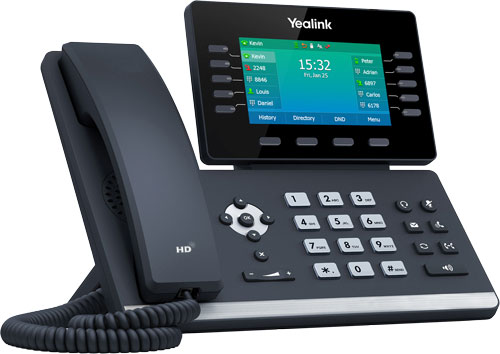
VoIP Phones for Restaurants
What phone you buy is determined by two questions: Who’s taking the call? How mobile do they have to be?
When it comes to restaurants, there are two types of VoIP phones to think about: desk phones and wireless phones. By desk phone, we simply mean the standard phone with a base and corded handset.
If the person taking calls doesn’t need to be mobile, a desk phone is a great option. You don’t need to look at the elite phones with video integration, huge displays, support for expansion modules, and so on.
You need a phone that is affordable, long-lasting, and offers good audio quality.
With desk phones, the primary consideration we recommend you think about (after compatibility — always check compatibility!) is the user interface. In a restaurant, the user might have bits of food on their hands or their hands might be wet from washing them, so you’ll want to avoid phones with touchscreen displays. You know how annoying it can be to use your smartphone when you want to switch tracks while washing your dishes? Yeah, that.
So you’ll probably want a physical key based interface, which, thankfully, is still the more common type of phone. Think about how many quick action keys you’ll need. These keys will let you speed dial an extension, use your phone as a paging microphone, and many other potential actions. A phone with 4 to 8 keys will probably suffice for almost all restaurants, but it really depends on your specific needs.
Look for noise cancellation technologies. Restaurants are loud spaces: music, conversations, calling orders and clanking pots and on and on. There are technologies initially intended for business calls that can really help in a restaurant. For example, Poly Acoustic Fence uses microphones to sense how far away sound is coming from. You then set a distance beyond which all noise will be cancelled. The result? A virtual wall between your phone and what’s happening in the restaurant — excellent noise cancellation. And there are many other noise cancellation technologies known by many terms.
One last consideration: If you don’t want to worry about running Ethernet cables, look for a Wi-Fi desk phone like Yealink T54W. Just know: You’ll have to make sure your Wi-Fi network is fast and stable. An Ethernet cable is more reliable.
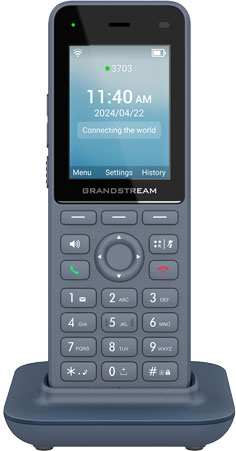
Mounting Options
How do you want to mount the phone: on a wall or on a table?
In many cases, wall-mounting the phone makes it easier to access. Some phones come with a wall mount bracket or a reversible mount that can be used both as a table stand and as a wall mount bracket. For many phones, however, you’ll need to buy a separate wall mount bracket. We strongly recommend you go with the official wall mount bracket for your phone for proper fit. You don’t want your phone falling off the wall when a waiter accidentally hits it.
If you’re having trouble figuring out what wall mount bracket you need to buy (it can be confusing), get in touch and one of our friendly experts will help!
On the other hand, if the person who takes the calls is always at the front desk, using the desk stand that comes in the box is perfectly fine.
What About a Headset?
You might also think about a Wireless Headset, which is very convenient for keeping your hands free as you work. Look for a one-ear headset, known as a mono headset or monaural headset, which keeps an ear uncovered to hear what’s happening around you.
That said, we’d strongly caution you from using a headset if multiple people need to wear it. Hygiene, you know?
Speaking of wireless headsets, let’s talk about wireless phones.
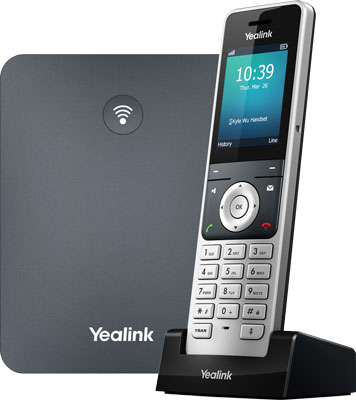
Wireless VoIP Phones: Wi-Fi vs DECT
If the person answering the phone needs to be mobile, you should consider a Wireless VoIP Phone. For example, they might need to check on an order, wait on tables, or take the trash out. You don’t want to miss a call.
There are two types to know about: Wi-Fi phones and DECT handsets.
Wi-Fi phones like Grandstream WP826 connect to the phone system directly over your Wi-Fi network. DECT handsets like Yealink W76P connect to a base station via DECT, which connects to the phone system via an Ethernet cable. DECT is a well-established wireless communications protocol that’s different from Wi-Fi and Bluetooth.
Both types have advantages and disadvantages.
Wi-Fi phones are simpler to set up initially, because you don’t need to worry about a separate base station. Many people appreciate simplicity.
On the other hand, you need to have really good Wi-Fi everywhere you want to use the phone, or else the quality of your call might be greatly diminished or even fail altogether. This might require, in larger restaurants, setting up multiple Wi-Fi repeaters or a mesh router system. Make sure the Wi-Fi phone supports roaming if you use multiple wireless access points.
DECT handsets with base stations require a bit more work to set up initially. Because it needs to communicate with a base station, it has to always be in reach of a base station.
Thankfully, DECT has longer distance connectivity than Wi-Fi or Bluetooth. There are also DECT repeaters that can extend the reach of the system. Using DECT also means you won’t have a Wi-Fi network that might be accessible to bad actors.
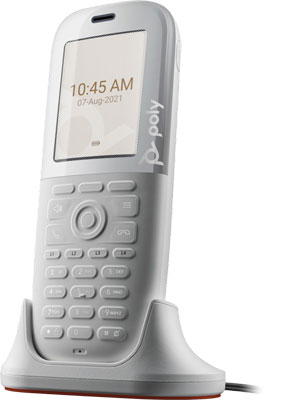
Ruggedized Handsets
Restaurants can be harsh on devices. You need to make sure that your phone isn’t ruined if you accidently drop it into the pasta dough.
Look for ruggedized handsets like Poly Rove 40.
You might look at what durability standards that the phone meets. The two most common standards are IP and IK. IP ratings determine how well a device prevent dust and water ingress. IK ratings determine how well a device deals with shocks. If you’re worried about liquids, look at the IP rating. If you’re worried about the phone being dropped, look at the IK rating.
Some phones are designed to be washable, which helps when it gets splattered by pizza sauce.
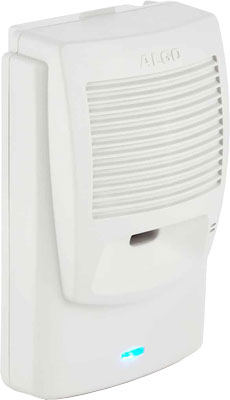
Loud Ringers for Restaurants
It can be chaotic and noisy in a restaurant. For example, the kitchen might be so loud that it can be hard to hear the phone ringing. If you’re afraid of missing a call, you might consider a loud ringer.
A loud ringer like Algo 8180 is an external speaker that amplifies the volume of a phone ring beyond what the phone can do by itself.
It’ll prevent you from missing a vital call, even in the chaos of a kitchen in the business distract at noon on Friday.
If you’d like to know more about loud ringers, check out our blog, “Loud Ringers and Strobes for VoIP.”

